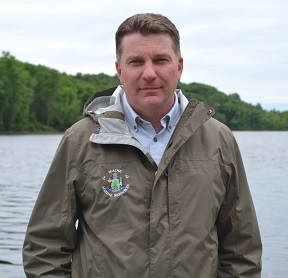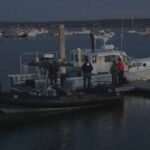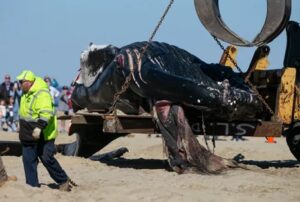Tag Archives: Kristan Porter

Role of Unionized Firms at Center of Maine’s Offshore Wind Debate
On Thursday the Maine Legislature’s Energy, Utilities and Technology Committee held a public hearing on a proposal to pave the way for the development of offshore wind infrastructure in the Gulf of Maine, including the construction of a coastal manufacturing facility that would build the offshore floating wind turbines Lawmakers also considered Thursday Rep. Tiffany Strout’s (R-Harrington) LD 1884, a bill that would block offshore wind developments. In recent years, the prospect of filling the Gulf of Maine with hundreds of wind turbines has taken on an air of inevitability, with environmental groups, industry groups, and well-paid lobbyists pouring millions of dollars into political pressure campaigns and ad campaigns designed to build support for the project. Unions, construction companies, investment companies, and lobbyists are all lining up to secure their share of what could be one of the largest taxpayer-funded projects in the history of the state. >click to read< 09:42

A year after record-breaking catch, value of Maine lobster landings are lowest in a decade
Maine lobstermen hauled in the least valuable lobster catch in a decade last year, when a decrease in price per pound and higher operational costs gave them less incentive to get out on the water. The $389 million haul, a 47% drop from 2021’s record-shattering catch,,, The size of the haul, 98 million pounds, was nearly identical to the 10-year low hit in 2020, when lobstermen also scaled back operations, then because of the closure of traditional markets as a result of the pandemic. Kristan Porter, a lobsterman from Cutler and president of the Maine Lobstermen’s Association, laid the blame for the drop in price per pound squarely on the economy. >click to read< 11:06

Fishermen reeling as further whale protection measures fast tracked
Maine lobstermen worry that their fate is sealed. Dozens gathered Tuesday evening in the Ellsworth Elementary-Middle School cafeteria for a livestream of a NOAA Fisheries scoping session on modifications to the Atlantic Large Whale Take Reduction Plan. Hundreds more participated online. Spurred by a recent court ruling, federal regulators are fast tracking plans to achieve a 90 percent reduction in entanglement risk. “These are measures that are going to really hurt and there were measures that were put forth that look really bad that didn’t come close to 90 percent, so I want people to realize that this is real, that this is coming and it’s not going to be pretty,” said Kristan Porter, president of the Maine Lobstermen’s Association and an Atlantic Large Whale Take Reduction Team member. >click to read< 10:15

Maine lobstermen appeal federal judge rejection of lawsuit
The Maine Lobstermen’s Association is appealing a federal judge’s ruling that rejected a lawsuit aimed at blocking new regulations designed to protect the endangered North Atlantic Right Whale. The appeal goes to the United States Court of Appeals for the District of Columbia Circuit. In announcing their appeal Monday morning, the MLA said the regulations would “cripple” Maine’s lobster industry, calling the regulations “draconian and fundamentally flawed.” >click to read< 09:42

America’s scallop harvest projected to decline again in 2022
The decline in scallops is happening as prices for the shellfish, one of the most lucrative seafoods in America, has increased amid inflation and fluctuations in catch. Seafood counters that sold scallops for $20 per pound to customers two years ago often sell them for $25 per pound or more now. U.S. scallop fishers harvested more than 60 million pounds of scallops in 2019, but the catch has declined since, and fishers were projected to harvest about 40 million pounds of scallops in the 2021 fishing year. That number is projected to fall to 34 million pounds in the 2022 fishing year, which started this spring, according to the New England Fishery Management Council. >click to read< 13:48

Lobster prices dropping
The price of lobster and seafood at large has shot up in recent years, and the price to lobster fishermen at the docks increased by about 60% last year. But lobster prices appear to be leveling off, and some retailers are selling the prized crustaceans for a couple dollars less than last year. Members of the industry said the price to fishermen is also falling at a time when they are struggling with high bait and fuel prices and costly gear conversations intended to try to protect rare whales. “And that’s why it’s hard, if bait was up and fuel was up and the price of lobsters was up, you’d be where you always are,” said Kristan Porter, president of the Maine Lobstermen’s Association. “But with those down, that makes it hard to justify going in.” >click to read< 12:08

Maine lobster industry salvaged its summer despite pandemic
The Maine lobster industry is in the midst of a multiyear boom, and fishermen have caught more than 100 million pounds (45,360,000 kilograms) for a record nine years in a row. It’s hard to guess whether they’ll reach that total again, but summer 2020 hasn’t been half bad for a season in which many fishermen expected collapse, said Kristan Porter, president of the Maine Lobstermen’s Association. “Especially early in the season when nothing was open, no restaurants were open. We were thinking it would be a complete disaster,” Porter said. “If it stays like this, we can struggle through and have a season, and then get ready to fish next year.”>click to read< 17:03

Everything you’ve heard about ‘ropeless’ fishing gear is false.
Is so-called “ropeless” fishing gear the magic bullet for the perceived problem of marine mammal interactions in California’s crab fisheries? (what about the New England lobster fishery?) Several profit-driven environmental groups, including Oceana, would like the public and the California Department of Fish and Wildlife (CDFW) to believe it is.,,, In truth, there have only been four mortalities attributed to CA commercial Dungeness crab gear since 2013, and none during the last two seasons.,,, Maine’s lobster fishery has never had a documented serious injury or mortality for any Right whale, and no entanglement since 2002, which makes this a non-problem. One of the problems with “ropeless” gear is that it’s a misleading term used by the profit-driven environmental groups to make it seem harmless. >click to read< 15:06

Maine: 1 in 3 Lobstermen got small Paycheck Protection Program loans
About $14.9 million in forgivable Paycheck Protection Program, or PPP, loans of less than $150,000 have been handed out to 1,358 Maine lobstermen, according to an analysis of newly released U.S. Small Business Administration data. That puts lobstermen ahead of full-service restaurants, real estate offices, beauty salons and home builders, which rounded out the top five Maine industries receiving small PPP loans. Maine’s $1.4 billion-a-year lobster industry – including those who buy, sell and process lobster as well as catch it – have received 1,495 forgivable PPP loans worth at least $24.2 million, so far. Fishermen got the lion’s share of the industry’s total PPP money, but only because they outnumber dealers, retailers and processors. Some dealers got loans of up to $1 million. >click to read< 07:15

Maine lobster group backs Canadian fishermen over right whale deaths
The president of the Maine Lobstermen’s Association, Kristan Porter, opposes a move to ban some Canadian seafood because of the deaths of endangered North Atlantic right whales in Canadian waters. “I think that doing that type of thing would only hurt the industry and not really solve the problem,” said Porter, a commercial fisherman from Cutler, Maine. Last September, nine conservation groups signed a letter urging the United States to ban Canadian snow crab imports when a new U.S. marine mammal protection act comes into force in 2022. >click to read< 07:54

Maine Seeks to Aid Lobstermen as Federal Whale Protections Loom
On Friday, the state’s Department of Marine Resources released a plan it says protects the endangered whales and lobstermen, whom the feds say need to do more to prevent traps and lines from killing the whale. Maine’s suggestions include having lobstermen use ropes with weak points the whales could easily break and calls for a 25% reduction in the amount of vertical trap lines. >click to read< 08:29
Maine Plan Aims To Reduce Lobstering Impact On Right Whales – The Maine Department of Marine Resources tweaked its October proposal to balance the needs of lobstermen while protecting the whales,,, >click to read< 09:32

Mills comes out against ‘foolish’ federal regulations to protect right whales
Gov. Janet Mills is directing the Maine Department of Marine Resources to come up with an alternative to a federal plan to protect the endangered right whale from the state lobster industry, saying she won’t allow “foolish” regulations to make life harder for the state’s fishermen.,,, Some fishermen complained that it took Mills too long to come to their defense, and some worried her feisty tone might prompt federal regulators to take even more drastic action to protect the right whale, but many welcomed the support from the Blaine House. “It’s nice to know the governor was listening to us,” said Cutler lobsterman Kristan Porter, the head of the Maine Lobstermen’s Association. >click to read< 18:30

Meetings Begin On New Lobster Gear Rules To Protect Right Whales
Maine lobstermen will meet with state marine resources officials in Trenton Tuesday evening to consider coming regulations that could force the industry to reduce by half the amount of fixed-gear trap rope placed in the ocean.,, Kristan Porter, president of the Maine Lobstermen’s Association, says it’s a difficult but attainable goal, whether through reducing actual per-boat trap numbers or by sinking more traps per line in the water.,,, Tonight’s meeting of the Lobster Zone B Council starts at 6 p.m. at the Trenton Elementary School. The Department of Marine Resources has scheduled such meetings in each of the state’s seven lobster zones over the course of this month. >click to read<12:21

New rules are meant to save whales; lobstermen wonder if they’ll survive
The state Department of Marine Resources has until September to come up with a way that it can cut the number of buoy lines in the Gulf of Maine by 50 percent. Federal regulators say that’s what it will take to reduce the risk of fatal entanglement enough for the species to survive. Scientists estimate only 411 right whales remain. The species has been on the brink of extinction before, most recently in 1992, when its population bottomed out at 295. It rebounded to about 500 in 2010, but low calving rates, ship strikes and fishing line entanglements have sent its numbers tumbling, yet again. But many in Maine’s $485 million industry worry it is the lobsterman who will face extinction,,, >click to read<10:28

Maine lobster fishery agrees to deep cuts to protect whales
After a long and difficult week in late April in which the National Oceanographic and Atmospheric Administration’s Marine Mammal Take Reduction Team met to address protections for the endangered right whale, the Maine lobster fishery now has a sense of what the future holds. There were some hard battles along the way, in which we lobster industry advocates fought to ensure a viable Maine fishery, both for today’s lobstermen and for future generations. By Patrice McCarron >click to read<14:39
Competing interests – “The farmer and the cowman should be friends,” according to Richard Rodgers’ lyrics in “Oklahoma!” Can a similar peace pact be visited upon Maine’s lobstermen and the advocates of whale safety? >click to read<

New protections for herring but lobster bait crunch imminent
Fishing managers are considering extending new protections to Atlantic herring, but catch quotas for the important bait fish are still likely to plummet before the end of the year, which is bad news for the American lobster industry.,, An arm of the Atlantic States Marine Fisheries Commission voted last month to initiate changes to try to better protect spawning herring off of New England.,, Lobstermen in Maine, the biggest lobster-fishing state, are on edge waiting for the news, said Kristan Porter, president of the Maine Lobstermen’s Association. >click to read<13:43

Lobsterman fear bait shortage with herring quota cut
At the height of the season, Brooklin lobsterman David Tarr spends $600 to $800 a day to bait his traps with herring, pogies or redfish. While some Maine lobstermen swear by herring, Tarr is willing to play the field based on price and availability. Unlike most of his peers, Tarr also has the luxury of a personal bait cooler, which allows him to buy bait when the price is right, salt it himself and store up to 200 barrels of it away — $40,000 of bait, enough for a half-season of fishing — for use during tough times. On Wednesday, one day after the New England Fisheries Management Council voted to recommend slashing the yearly herring quota by 80 percent, Tarr figures tough times are coming. “At a certain point, it is just not worth it,” Tarr said. “I won’t go fishing just to pay for my bait.”>click to read<14:03

Large pogy catch good news for Maine lobstermen who feared bait shortage
All of the landings have yet to be counted, but officials say it is likely that an unusually large pogy fleet will have caught almost 7 million pounds of the fish, which is more than double last year’s landings. This comes as especially good news for Maine lobstermen, who use pogies to bait their traps when the herring supply runs low, as it is expected to this year. “Every pogy used was herring not used,” said Kristan Porter, a Cutler lobsterman and president of the Maine Lobstermen’s Association, which has been working with its members to prepare them for the herring shortage. >click to read<07:09

Maine Lobstermen’s Association to replace longtime leader
The largest commercial fishing industry group on the East Coast will elect a new leader this Friday for the first time in 27 yearsa Cutler fisherman, is expected to take the reins of the Maine Lobstermen’s Association at the end of its annual meeting in Rockport. Porter, however, said it is “not a done deal” that he’ll become the group’s next president.,, The MLA was founded in 1954 and, with 1,200 members, bills itself as “the oldest and largest fishing industry association on the East Coast.” It holds its annual meeting each year at the Maine Fishermen’s Forum,,, >click to read< 07:24
Small Boat Fishermen Worry New Rules Won’t Come in Time to Save N. Atlantic Scallops
 A quandary over scallop rules has two groups of fishermen in Maine at odds over the increasingly lucrative shellfish. Kristan Porter, is an independent fisherman who catches lobsters for most of the year with his boat “Brandon Jay.” But for additional income, for five months each year, he and the two other men on his boat have begun collecting scallops. Eric Hansen, of New Bedford, Massachusetts, is one of the permit holders that aren’t bound by the same quota that Porter and others follow. Hansen, who typically fishes south of Maine, returned to the Gulf of Maine this year for the first time in decades. His family business obtained one of the permits back in 1994 for free that now could be sold for millions of dollars. Read the rest here 08:41
A quandary over scallop rules has two groups of fishermen in Maine at odds over the increasingly lucrative shellfish. Kristan Porter, is an independent fisherman who catches lobsters for most of the year with his boat “Brandon Jay.” But for additional income, for five months each year, he and the two other men on his boat have begun collecting scallops. Eric Hansen, of New Bedford, Massachusetts, is one of the permit holders that aren’t bound by the same quota that Porter and others follow. Hansen, who typically fishes south of Maine, returned to the Gulf of Maine this year for the first time in decades. His family business obtained one of the permits back in 1994 for free that now could be sold for millions of dollars. Read the rest here 08:41















































